airbag RENAULT TWINGO 2009 2.G Electrical Equipment - Multiplexing Workshop Manual
[x] Cancel search | Manufacturer: RENAULT, Model Year: 2009, Model line: TWINGO, Model: RENAULT TWINGO 2009 2.GPages: 33, PDF Size: 0.18 MB
Page 2 of 33
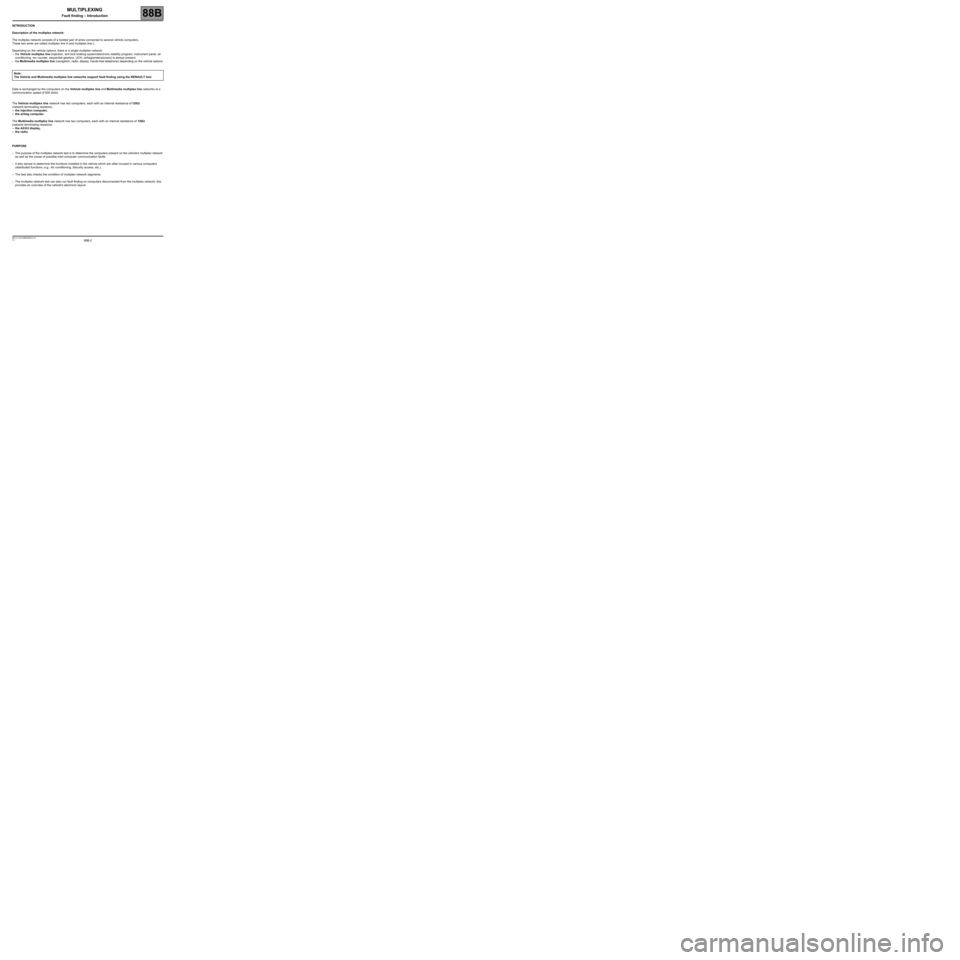
88B-2V3 MR-413-X44-88B000$010.mif
88B
INTRODUCTION
Description of the multiplex network:
The multiplex network consists of a twisted pair of wires connected to several vehicle computers.
These two wires are called multiplex line H and multiplex line L.
Depending on the vehicle options, there is a single multiplex network.
–the Vehicle multiplex line (injection, anti-lock braking system/electronic stability program, instrument panel, air
conditioning, rev counter, sequential gearbox, UCH, airbag/pretensioners) is always present,
–the Multimedia multiplex line (navigation, radio, display, hands-free telephone) depending on the vehicle options.
Data is exchanged by the computers on the Vehicle multiplex line and Multimedia multiplex line networks at a
communication speed of 500 kbit/s.
The Vehicle multiplex line network has two computers, each with an internal resistance of 120ΩΩ Ω Ω
(network terminating resistors):
–the injection computer,
–the airbag computer.
The Multimedia multiplex line network has two computers, each with an internal resistance of 120ΩΩ Ω Ω
(network terminating resistors):
–the A2/A3 display,
–the radio.
PURPOSE
–The purpose of the multiplex network test is to determine the computers present on the vehicle's multiplex network
as well as the cause of possible inter-computer communication faults.
–It also serves to determine the functions installed in the vehicle which are often housed in various computers
(distributed functions, e.g.: Air conditioning, Security access, etc.).
–The test also checks the condition of multiplex network segments.
–The multiplex network test can also run fault finding on computers disconnected from the multiplex network; this
provides an overview of the vehicle's electronic layout. Note:
The Vehicle and Multimedia multiplex line networks support fault finding using the RENAULT tool.
MULTIPLEXING
Fault finding – Introduction
Page 4 of 33
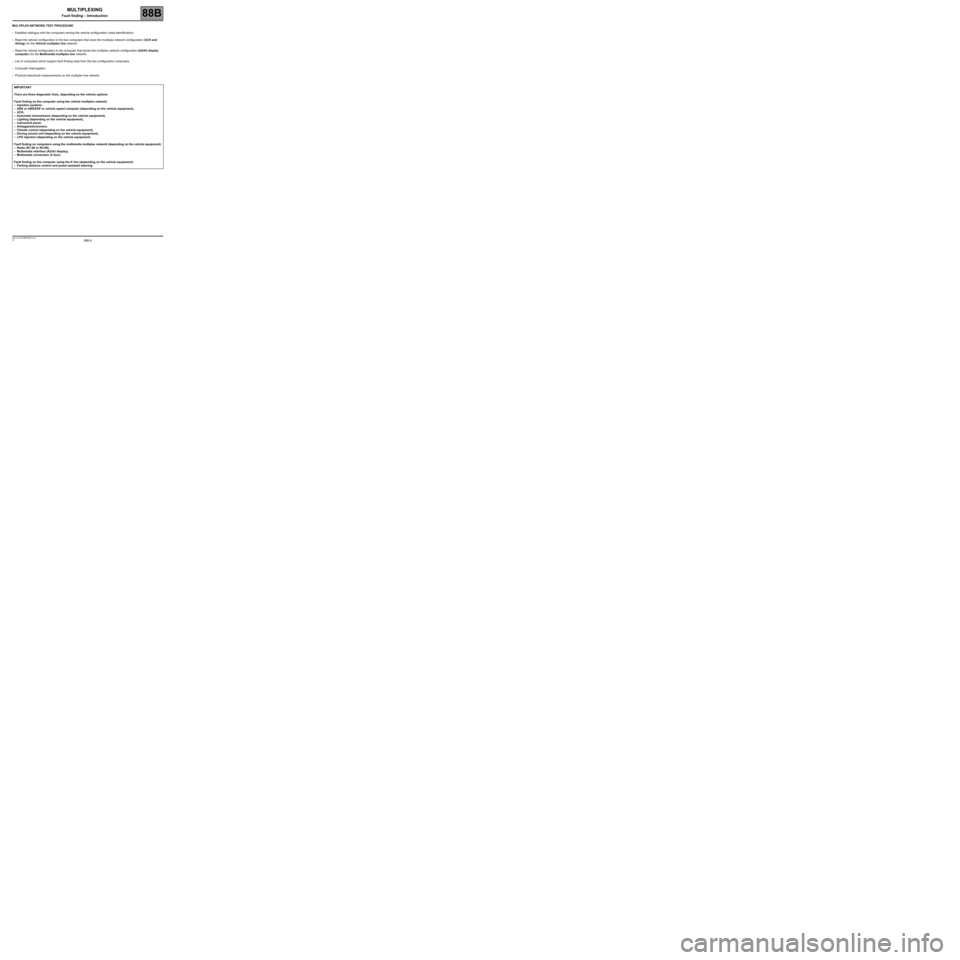
88B-4V3 MR-413-X44-88B000$010.mif
MULTIPLEXING
Fault finding – Introduction88B
MULTIPLEX NETWORK TEST PROCEDURE
–Establish dialogue with the computers storing the vehicle configuration (read identification).
–Read the vehicle configuration in the two computers that store the multiplex network configuration (UCH and
Airbag) for the Vehicle multiplex line network.
–Read the vehicle configuration in the computer that stores the multiplex network configuration (A2/A3 display
computer) for the Multimedia multiplex line network.
–List of computers which support fault finding read from the two configuration computers.
–Computer interrogation.
–Physical (electrical) measurements on the multiplex line network.
IMPORTANT
There are three diagnostic lines, depending on the vehicle options:
Fault finding on the computer using the vehicle multiplex network:
–Injection systems,
–ABS or ABS/ESP or vehicle speed computer (depending on the vehicle equipment),
–UCH,
–Automatic transmission (depending on the vehicle equipment),
–Lighting (depending on the vehicle equipment),
–Instrument panel,
–Airbag/pretensioners,
–Climate control (depending on the vehicle equipment),
–Driving school unit (depending on the vehicle equipment),
–LPG injection (depending on the vehicle equipment).
Fault finding on computers using the multimedia multiplex network (depending on the vehicle equipment):
–Radio (R1-08 or R2-08),
–Multimedia interface (A2/A3 display),
–Multimedia connection (C-box).
Fault finding on the computer using the K line (depending on the vehicle equipment):
–Parking distance control and power-assisted steering.
Page 8 of 33

88B-8V3 MR-413-X44-88B000$020.mif
88B
Multiplexing enables signals to be sent between different computers on the vehicle, such as:
119 Automatic transmission computer 756 Airbag pretensioners/computer
120 Injection computer 995 Electronic rev counter
247 Instrument panel 1094 ABS/ESP computer
419 Air conditioning computer 1222 Parking distance control computer
502 Power-assisted steering computer 261 Radio
645 UCH 225 Diagnostic socket
653 Multimedia interface (A2/A3 display) 1959 Multimedia connection (C-box)
1222 247 995
502
645
120 119 65310941959
225261419
756
MULTIPLEXING
Fault finding – List and location of components
Page 10 of 33
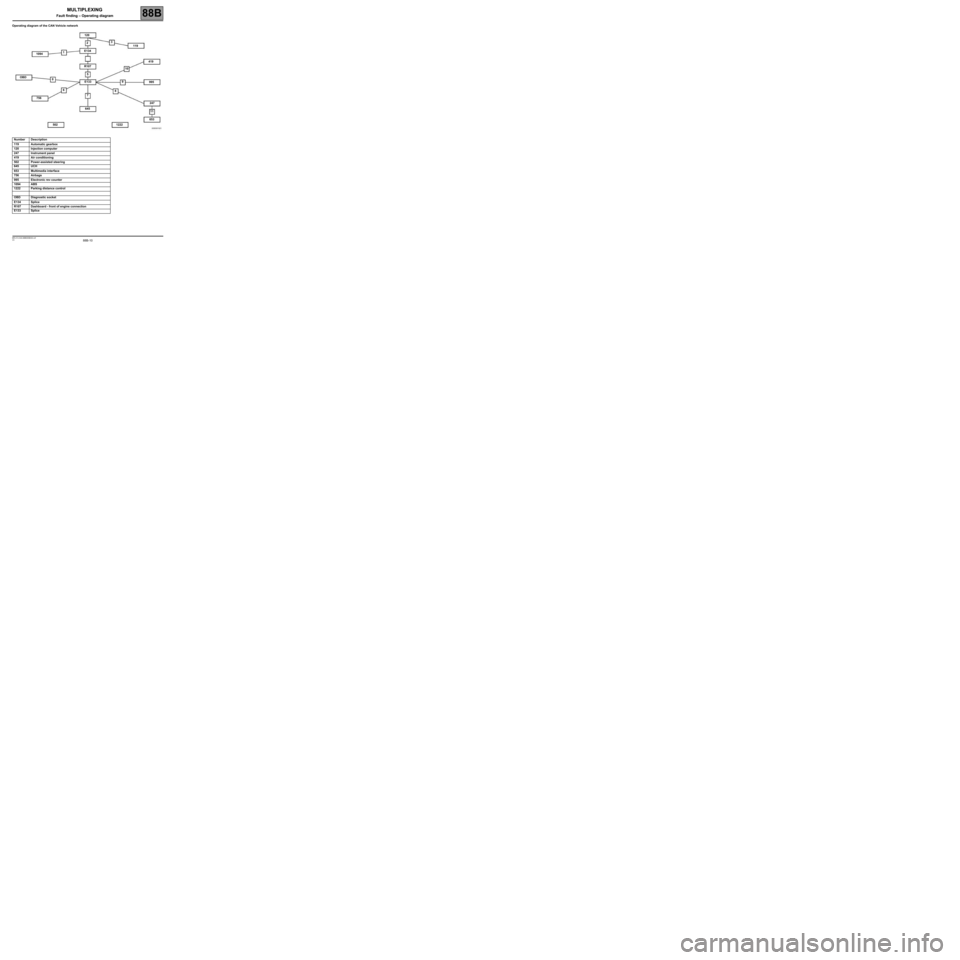
88B-10V3 MR-413-X44-88B000$030.mif
MULTIPLEXING
Fault finding – Operating diagram88B
Operating diagram of the CAN Vehicle network
Number Description
119 Automatic gearbox
120 Injection computer
247 Instrument panel
419 Air conditioning
502 Power-assisted steering
645 UCH
653 Multimedia interface
756 Airbags
995 Electronic rev counter
1094 ABS
1222 Parking distance control
OBD Diagnostic socket
E134 Splice
R107 Dashboard - front of engine connection
E133 Splice
120
010
11 123
5
6
7 89 OBDE134
E133 R107
645 1094119
419
995
247
653
1222 502 756
MULTIPLEXING
Fault finding – Operating diagram
Page 14 of 33
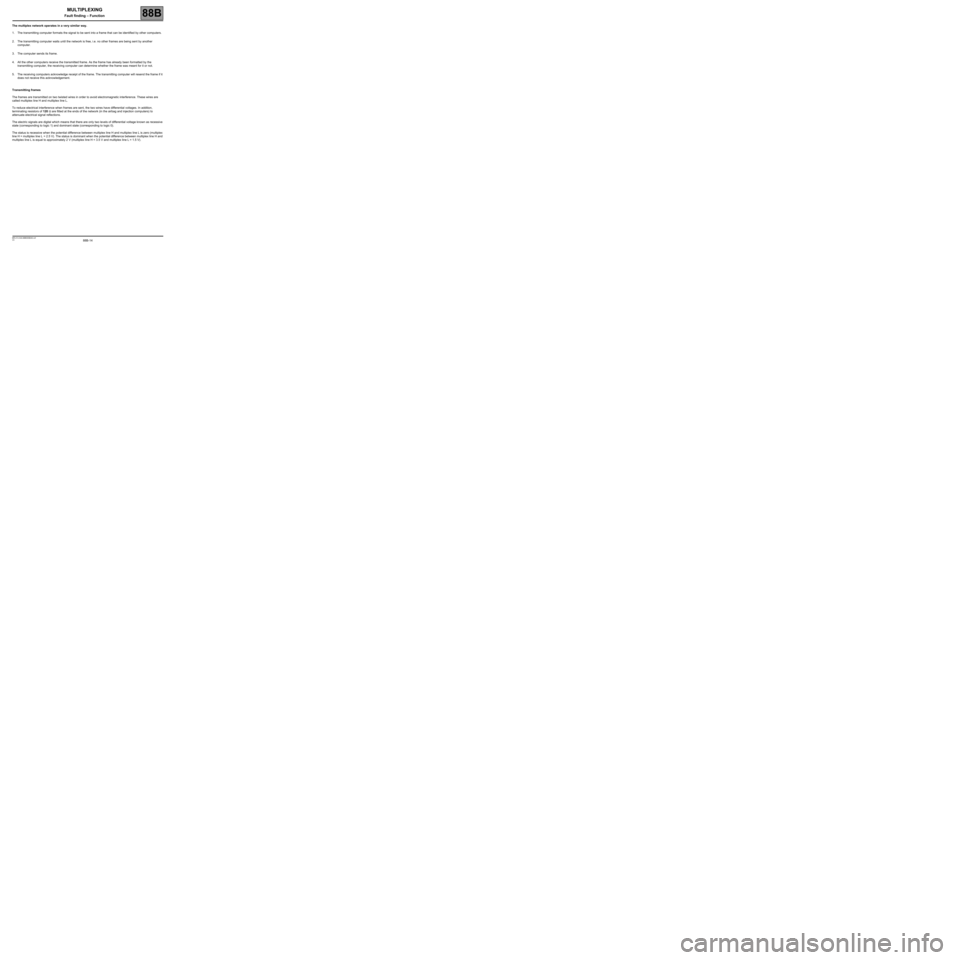
88B-14V3 MR-413-X44-88B000$040.mif
MULTIPLEXING
Fault finding – Function88B
The multiplex network operates in a very similar way.
1. The transmitting computer formats the signal to be sent into a frame that can be identified by other computers.
2. The transmitting computer waits until the network is free, i.e. no other frames are being sent by another
computer.
3. The computer sends its frame.
4. All the other computers receive the transmitted frame. As the frame has already been formatted by the
transmitting computer, the receiving computer can determine whether the frame was meant for it or not.
5. The receiving computers acknowledge receipt of the frame. The transmitting computer will resend the frame if it
does not receive this acknowledgement.
Transmitting frames
The frames are transmitted on two twisted wires in order to avoid electromagnetic interference. These wires are
called multiplex line H and multiplex line L.
To reduce electrical interference when frames are sent, the two wires have differential voltages. In addition,
terminating resistors of 120 Ω are fitted at the ends of the network (in the airbag and injection computers) to
attenuate electrical signal reflections.
The electric signals are digital which means that there are only two levels of differential voltage known as recessive
state (corresponding to logic 1) and dominant state (corresponding to logic 0).
The status is recessive when the potential difference between multiplex line H and multiplex line L is zero (multiplex
line H = multiplex line L = 2.5 V). The status is dominant when the potential difference between multiplex line H and
multiplex line L is equal to approximately 2 V (multiplex line H = 3.5 V and multiplex line L = 1.5 V).
Page 17 of 33
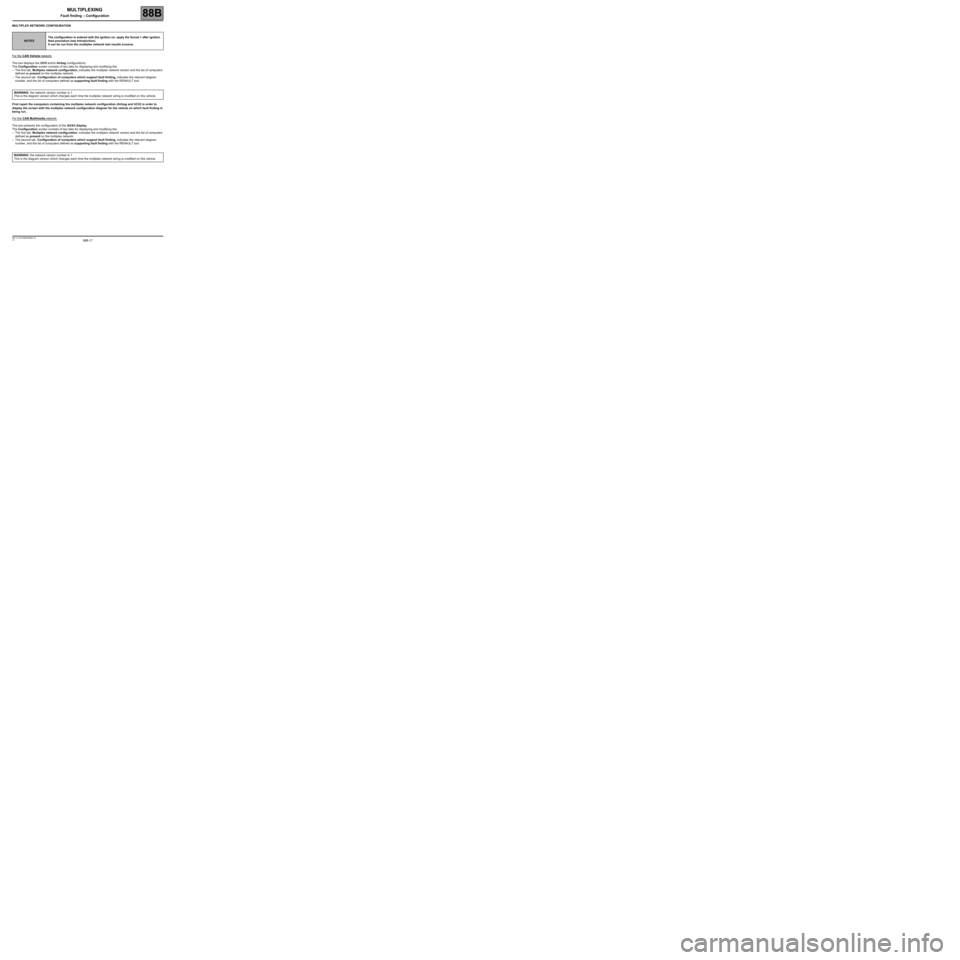
88B-17V3 MR-413-X44-88B000$060.mif
88B
MULTIPLEX NETWORK CONFIGURATION
For the
CAN Vehicle network:
The tool displays the UCH and/or Airbag configurations.
The Configuration screen consists of two tabs for displaying and modifying the:
–The first tab, Multiplex network configuration, indicates the multiplex network version and the list of computers
defined as present on the multiplex network.
–The second tab, Configuration of computers which support fault finding, indicates the relevant diagram
number, and the list of computers defined as supporting fault finding with the RENAULT tool.
First repair the computers containing the multiplex network configuration (Airbag and UCH) in order to
display the screen with the multiplex network configuration diagram for the vehicle on which fault finding is
being run.
For the
CAN Multimedia network:
The tool presents the configuration of the A2/A3 display.
The Configuration screen consists of two tabs for displaying and modifying the:
–The first tab, Multiplex network configuration, indicates the multiplex network version and the list of computers
defined as present on the multiplex network.
–The second tab, Configuration of computers which support fault finding, indicates the relevant diagram
number, and the list of computers defined as supporting fault finding with the RENAULT tool.
NOTESThe configuration is entered with the ignition on; apply the forced + after ignition
feed procedure (see Introduction).
It can be run from the multiplex network test results screens.
WARNING: the network version number is 1.
This is the diagram version which changes each time the multiplex network wiring is modified on this vehicle.
WARNING: the network version number is 1.
This is the diagram version which changes each time the multiplex network wiring is modified on this vehicle.
MULTIPLEXING
Fault finding – Configuration
Page 19 of 33
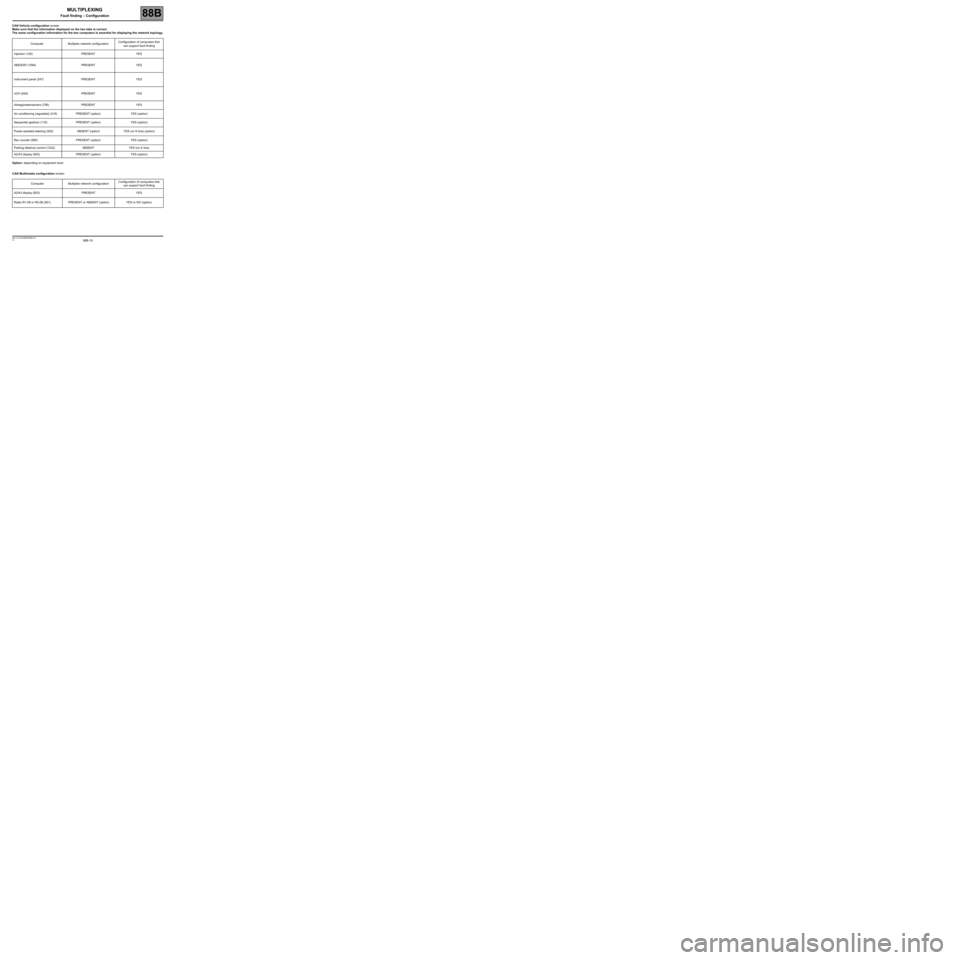
88B-19V3 MR-413-X44-88B000$060.mif
MULTIPLEXING
Fault finding – Configuration88B
CAN Vehicle configuration screen
Make sure that the information displayed on the two tabs is correct.
The same configuration information for the two computers is essential for displaying the network topology.
Option: depending on equipment level
CAN Multimedia configuration screen Computer Multiplex network configurationConfiguration of computers that
can support fault finding
Injection (120) PRESENT YES
ABS/ESP (1094) PRESENT YES
Instrument panel (247) PRESENT YES
UCH (645) PRESENT YES
Airbag/pretensioners (756) PRESENT YES
Air conditioning (regulated) (419) PRESENT (option) YES (option)
Sequential gearbox (119) PRESENT (option) YES (option)
Power-assisted steering (502) ABSENT (option) YES (on K line) (option)
Rev counter (995) PRESENT (option) YES (option)
Parking distance control (1222) ABSENT YES (on K line)
A2/A3 display (653) PRESENT (option) YES (option)
Computer Multiplex network configurationConfiguration of computers that
can support fault finding
A2/A3 display (653) PRESENT YES
Radio R1-08 or R2-08 (261) PRESENT or ABSENT (option) YES or NO (option)
Page 20 of 33
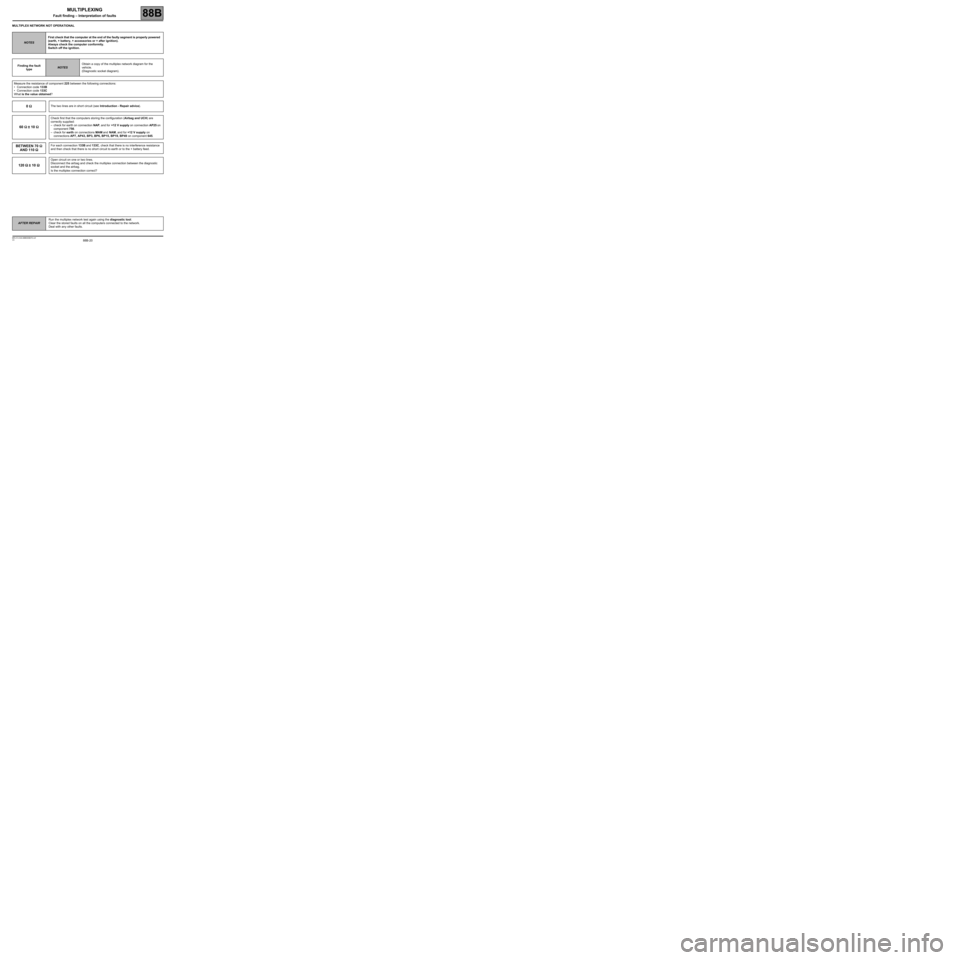
88B-20
AFTER REPAIRRun the multiplex network test again using the diagnostic tool.
Clear the stored faults on all the computers connected to the network.
Deal with any other faults.
V3 MR-413-X44-88B000$070.mif
88B
MULTIPLEX NETWORK NOT OPERATIONAL
NOTESFirst check that the computer at the end of the faulty segment is properly powered
(earth, + battery, + accessories or + after ignition).
Always check the computer conformity.
Switch off the ignition.
Finding the fault
type
NOTESObtain a copy of the multiplex network diagram for the
vehicle.
(Diagnostic socket diagram).
Measure the resistance of component 225 between the following connections:
•Connection code 133B
•Connection code 133C
What is the value obtained?
0 ΩΩ Ω ΩThe two lines are in short circuit (see Introduction - Repair advice).
60 ΩΩ Ω Ω
± 10 ΩΩ Ω Ω
Check first that the computers storing the configuration (Airbag and UCH) are
correctly supplied:
–check for earth on connection NAP, and for +12 V supply on connection AP25 on
component 756.
–check for earth on connections MAM and NAM, and for +12 V supply on
connections AP7, AP43, BP3, BP6, BP15, BP19, BP49 on component 645.
BETWEEN 70 ΩΩ Ω Ω
AND 110 ΩΩ Ω ΩFor each connection 133B and 133C, check that there is no interference resistance
and then check that there is no short circuit to earth or to the + battery feed.
120 ΩΩ Ω Ω
± 10 ΩΩ Ω Ω
Open circuit on one or two lines.
Disconnect the airbag and check the multiplex connection between the diagnostic
socket and the airbag.
Is the multiplex connection correct?
MULTIPLEXING
Fault finding – Interpretation of faults
Page 21 of 33
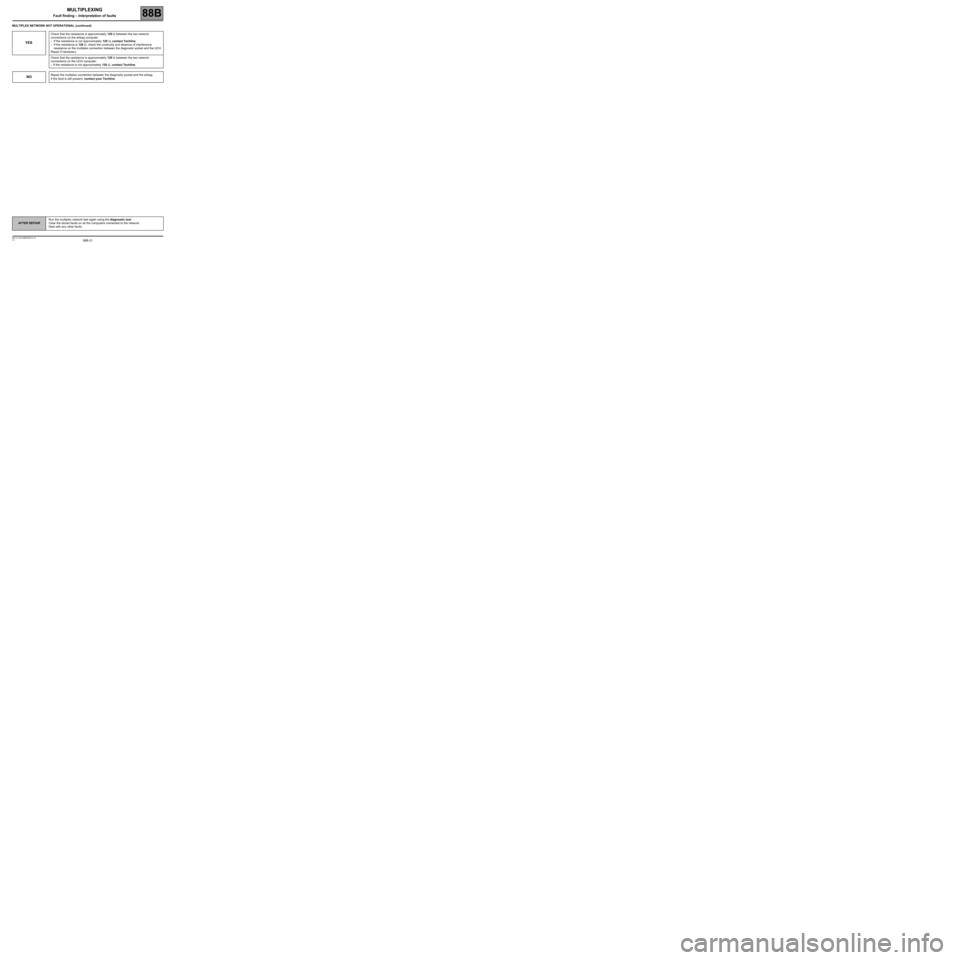
88B-21
AFTER REPAIRRun the multiplex network test again using the diagnostic tool.
Clear the stored faults on all the computers connected to the network.
Deal with any other faults.
V3 MR-413-X44-88B000$070.mif
MULTIPLEXING
Fault finding – Interpretation of faults88B
MULTIPLEX NETWORK NOT OPERATIONAL (continued)
YES
Check that the resistance is approximately 120 Ω between the two network
connections on the airbag computer:
–If the resistance is not approximately 120 Ω, contact Techline.
–If the resistance is 120 Ω, check the continuity and absence of interference
resistance on the multiplex connection between the diagnostic socket and the UCH.
Repair if necessary.
Check that the resistance is approximately 120 Ω between the two network
connections on the UCH computer:
– If the resistance is not approximately 120 Ω, contact Techline.
NORepair the multiplex connection between the diagnostic socket and the airbag.
If the fault is still present, contact your Techline.
Page 23 of 33
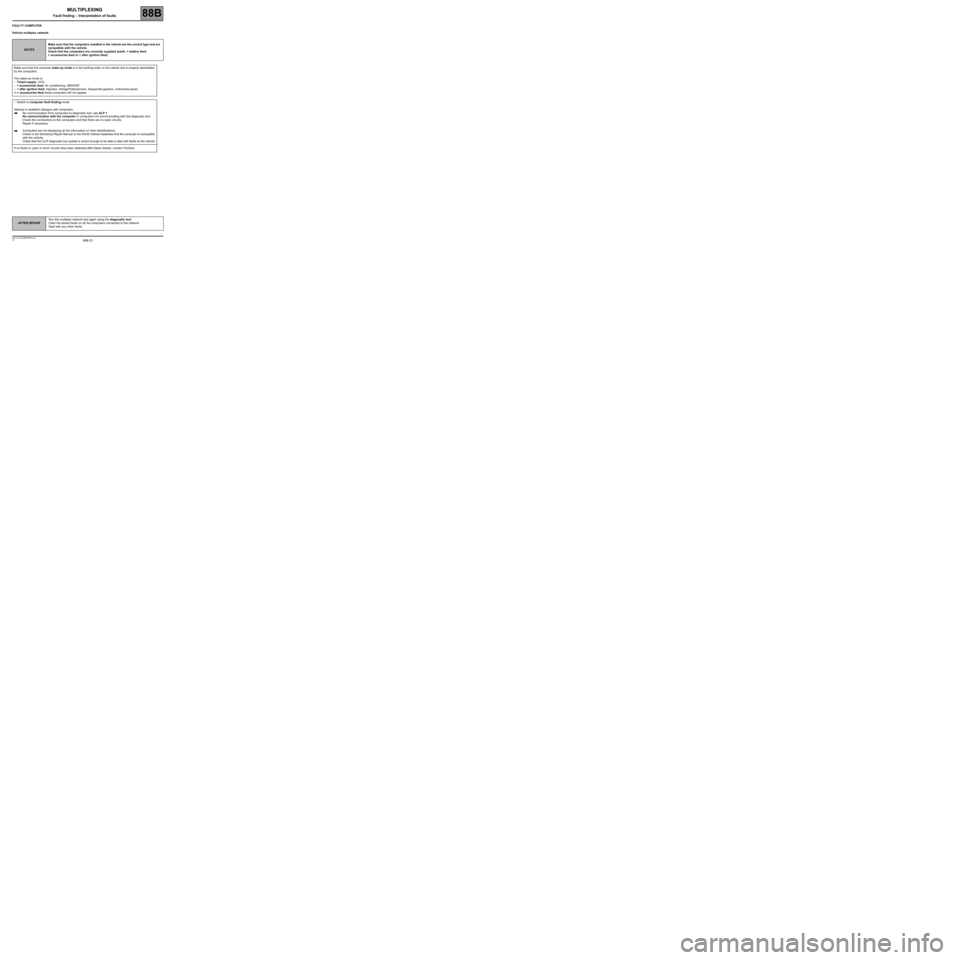
88B-23
AFTER REPAIRRun the multiplex network test again using the diagnostic tool.
Clear the stored faults on all the computers connected to the network.
Deal with any other faults.
V3 MR-413-X44-88B000$070.mif
MULTIPLEXING
Fault finding – Interpretation of faults88B
FAULTY COMPUTER
Vehicle multiplex network
NOTESMake sure that the computers installed in the vehicle are the correct type and are
compatible with the vehicle.
Check that the computers are correctly supplied (earth, + battery feed,
+ accessories feed or + after ignition feed).
Make sure that the computer wake-up mode is in full working order on the vehicle and is properly assimilated
by the computers.
The wake-up mode is:
–Timed supply: UCH,
–+ accessories feed: Air conditioning, ABS/ESP.
–+ after ignition feed: Injection, Airbag/Pretensioners, Sequential gearbox, Instrument panel.
In + accessories feed these computers will not appear.
–Switch to computer fault finding mode.
Attempt to establish dialogue with computers.
No communication from computers to diagnostic tool: see ALP 1
No communication with the computer or computers not communicating with the diagnostic tool.
Check the connections to the computers and that there are no open circuits.
Repair if necessary.
Computers are not displaying all the information on their identifications:
Check in the Workshop Repair Manual or the World Vehicle Database that the computer is compatible
with the vehicle.
Check that the CLIP diagnostic tool update is recent enough to be able to deal with faults on the vehicle.
If no faults or open or short circuits have been detected after these checks, contact Techline.